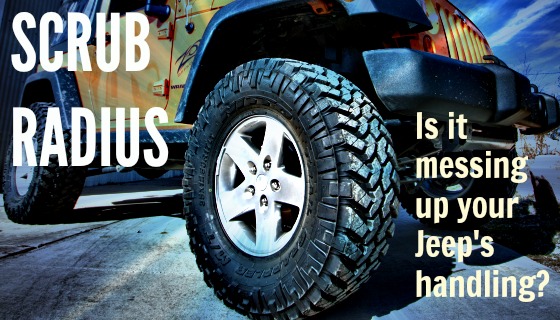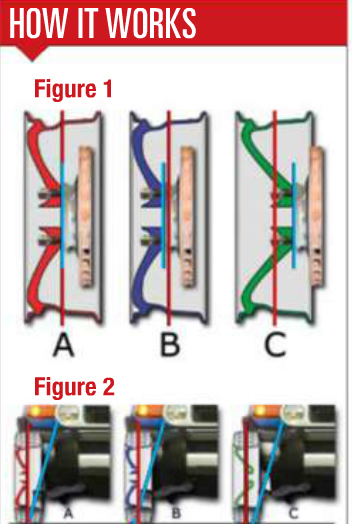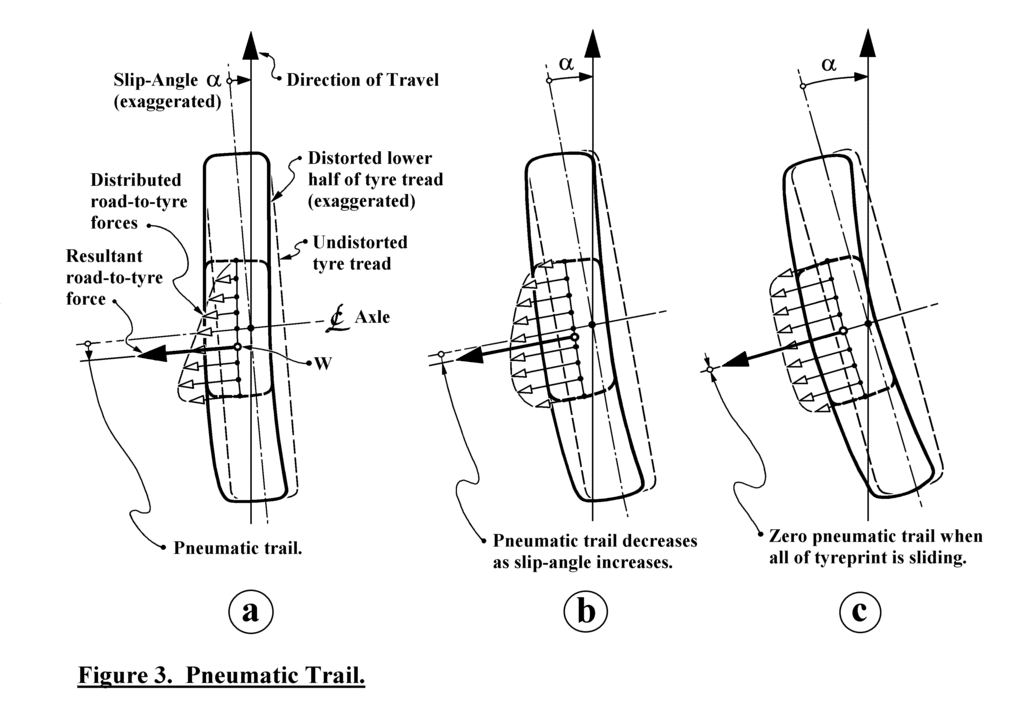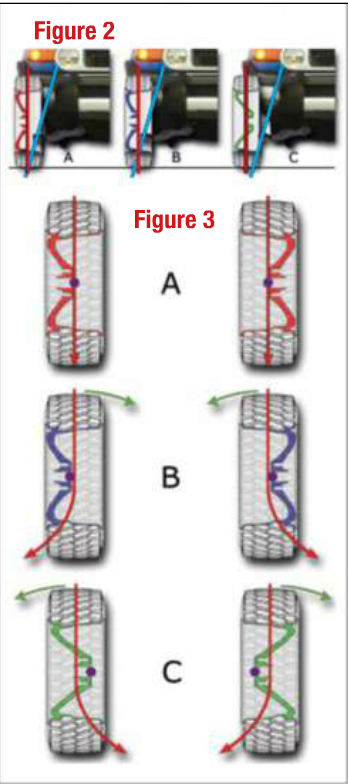Want to add larger wheels and tires to your Jeep without totally ruining your handling? Then you need to know about scrub radius.

So You Just Lifted Your Jeep
So you are proud of yourself for having just completed your own lift kit installation with no help but the manual downloaded from the Jeep Parts store where you ordered the lift kit and an IPad in your garage playing Youtube video tutorials.
Then you take it out for a ride and you are crestfallen. The handling is just not good. You wanted to lift your Jeep in order to fit on those stylishly aggressive bigger wheels and tires. Now you are racking your brain trying to figure out what went wrong during the installation.
Well guess what? It may not be the installation of the lift kit at all. It may be those new wheels and tires that you installed at the same time you installed the lift kit. Did you fit a wider rim with a different offset to the original specifications? If you did, then your problem may be a negative scrub radius, Buddy.
Wheel Offset, What Is It?
Okay, first let's talk about wheel offset. Wheel offset is the distance between the centre line of the rim and the inner face of the rim that seats against the wheel hub - the seat face. You know what? This is way better explained with some illustrations. So let me turn it over to those smart college guys at Engineering Explained:
Steering Axis Inclination - Explained
Provides information on steering axis inclination and the role it plays on automobiles. Part of a 4 part series of shorts on wheel alignmentTypically, offest is measured in millimetres. Check out Figure 1. In it there are three rims with three unique offsets. That red line bifurcating the wheels is the center line. The blue line is the seat face that sets against the hub of the wheel.

Figures 1 and 2: That red line bifurcating the wheels is the center line. The blue line is the seat face that sets against the hub of the wheel.
Rim A has zero offset because the seat face and the center line are in the same position. Rim B has what is called a positive offset because the center line sits inward from the seat face, more towards the engine. Rim C has a negative offset because the center line sits more away from the engine in relation to the seat face. So zero if seat face and center line are lined up perfectly. Positive if the center line is more towards the engine and negative if the center line is more away from the engine. Got that? If you don't that is okay. Here is a video that explains it a little bit more illustratively.
Wheel Offsets 101
Why are wheel offsets so crucial to your overall driving experience?Now, about that aggressive stance you wanted. Sometimes to get a "look" a driver will place the wheels wide so that they stand out from the body of the Jeep rather than sit flush under it. It is a hot look to be sure, but it can wreak havoc on the way the care drives. To understand why this is, let me tell you about scrub radius.
Scrub Radius, What Is it?
Check out figure two. The red line is still the center line of the wheel, just like in Figure 1. The blue line is the KPI, king pin inclination. Think of this like the equator, an imaginary line that cuts through the upper and lower axis points of the the front suspension. If you can not picture what I am saying maybe this video will help. In this video they are calling it steering axis inclination, but it is the same thing, only I am talking about king pins instead of ball joints.
Steering Axis Inclination Illustrated
Find out how to make sure your steering axis is correct.Okay, now that you understand KPI, let's go back to our review of Figure 2. So in Figure 2 the swivel points through which the imaginary line is drawn would be the upper ball joints. At least this is how it is in most 4 wheel drive vehicles with an independent front suspension. If it is a solid axle vehicle, the swivel points would be the center of the upper and lower swivel bearings at the end of the axle. So, just like the equator, your front wheels turn around the axis of the KPI line. When you turn the wheel, the tire will rotate around the point where the axis meets the asphalt.
Look at vehicle A in Figure 2. It has zero offset so the KPI line meets the surface of the road right in the center of the wheel. When the wheel was turned the tire would rotate right around its center. Vehicle A is said to have a scrub radius of zero.
In vehicle B there is a positive offset. The KPI line is meeting the road towards the outside of the tire. When the vehicle B tire turns, it will rotate around this outer point and the inner surface of the tire will scrub more as the tire rotates around its KPI line. The scrub radius on vehicle B would be a negative number.
Vehicle C has wheels with a negative offset. The KPI line is meeting the road's surface towards the inside of the tire. When the wheel turns the tire is rotating around this inner point and it is the outer surface of the tire that is going to scrub more as the tire rotates around the KPI line. Vehicle C has a scrub radius that is a positive number.
Figure 3 illustrates scrub radius with a side view that better shows the "scrub" in scrub radius. You see how the tire gets pinched as it meets the road's surface in negative or positive offset situations. This creates extra wear on the tire and also negative effects the handling of the vehicle. But how?

Figure3: In this side view illustration it is easier to see how the tire gets pinched as it meets the road's surface.
In Figure 4 we are looking at the front wheel tires from directly above. As the car moves forward, different forces act on the wheel, pushing it backwards. The particular force on which we are focusing is friction. This is especially true when braking. If the tire tread is even and the camber is close to zero, friction will be distributed down the center of the wheel. In Figure 4.3 friction pushing backward is indicated by the red arrow. The purple dot indicates the KPI-to-road-surface contact point. This is the point around which the wheel is rotating.

Figure 4: Friction pushing backward is indicated by the red arrow. The purple dot indicates the KPI-to-road-surface contact point.
Now look at Vehicle A in Figure 4.3. This is the vehicle with a scrub radius of zero. You see how the purple dot indicating the point around which the wheel rotates is right in the center of the wheel. It is in the same position as the force of friction. Thus the friction has no effect on the toe of the front wheels and the vehicle steering stays straight.
Where Negative Scrub Radius Leads To Instability
Vehicle B in Figure 4.3 has a negative scrub radius so the purple dot is towards the outside of the force of friction. This means that the force of friction is pushing the toe of the front wheel in, as show by the green arrows. Toe-in pushing provides increased stability.
But in Vehicle C in Figure 3 there is decreased stability. The scrub radius is positive. The purple dot is inward from the force of friction. So friction pushes the toe of the tire outward, causing wandering.
The larger the scrub radius the more effect it will have on the handling of the vehicle.
Car makers calculate all the various suspension angles and steering angeles when they engineer the car. This includes the amount of wheel offset and scrub radius. When drivers modify their cars and change up the offset from the original design, the risk is that the modification may include a larger degree of scrub radius. This includes modifications like wheel spacers. And you don't have to be doing any crazy driving to feel the effects scrub radius has on handling. You can feel it just driving on the asphalt within the speed limit.
The point, obviously, is not to discourage modifications. Modifications are a Jeep way of life. The point is to encourage studied modifications in which you have done all the calculations to insure that you are installing parts in such a way that scrub radius does not become a dangerous issue in the handling of your Jeep.



